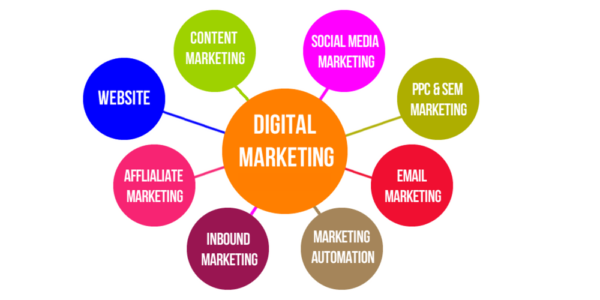What is Digital Marketing?
All marketing initiatives that make use of electronic devices or online resources are included in the category of Digital Marketing. It includes providing consumers with product and service promotion and advertising via digital platforms and technologies. This can comprise several methods:

Content Marketing:
- Content Marketing involves creating and distributing valuable, relevant, and consistent content to attract and retain a clearly defined audience.
- Content can take various forms such as articles, videos, infographics, podcasts, and more.
- The primary goal is to provide value to the audience, establish brand credibility, and ultimately drive profitable customer action.
Social Media Marketing:
- Social Media Marketing focuses on leveraging social media platforms like Facebook, Instagram, Twitter, LinkedIn, and others to connect with audiences and promote products or services.
- It involves creating engaging content, interacting with users, running ads, and building communities around brands.
- Social media platforms offer powerful targeting options, allowing marketers to reach specific demographics with precision.
Search Engine Optimization (SEO):
- SEO is the practice of optimizing a website to rank higher in search engine results pages (SERPs) for relevant keywords and phrases.
- By improving visibility in organic search results, businesses can attract more traffic, enhance brand visibility, and generate leads.
- SEO involves various tactics such as keyword research, on-page optimization, link building, and technical optimization.
Email Marketing:
- Email Marketing involves sending targeted, personalized emails to a list of subscribers to nurture relationships, promote products or services, and drive conversions.
- It’s an effective way to communicate directly with prospects and customers, delivering relevant content and offers directly to their inbox.
- Successful email marketing campaigns often rely on segmentation, automation, and analytics to optimize performance.
Pay-Per-Click (PPC):
- PPC advertising allows businesses to place ads on search engines or social media platforms and pay a fee each time a user clicks on the ad.
- It provides immediate visibility and can be highly targeted based on keywords, demographics, interests, and behaviors.
- PPC campaigns require careful planning, keyword research, ad copy optimization, and ongoing monitoring to maximize ROI.
Affiliate Marketing:
- Affiliate Marketing involves partnering with individuals or other businesses (affiliates) who promote your products or services in exchange for a commission on sales.
- It’s a performance-based marketing strategy where affiliates earn a commission for driving traffic or sales to the advertiser’s website through their marketing efforts.
- Affiliate marketing programs can help businesses expand their reach, increase sales, and achieve a higher return on investment (ROI).
Influencer Marketing:
- Influencer Marketing focuses on collaborating with influential individuals (influencers) who have a dedicated following and credibility in a particular niche or industry.
- By partnering with influencers, brands can tap into their engaged audience, build trust, and drive awareness and sales.
- Influencer marketing campaigns can take various forms, including sponsored content, product placements, giveaways, and more.
Mobile Marketing:
- Mobile Marketing targets audiences on mobile devices such as smartphones and tablets through channels like mobile apps, SMS (text messaging), and optimized websites.
- With the increasing use of mobile devices, mobile marketing offers opportunities to reach consumers in real-time, wherever they are.
- Mobile marketing strategies may include location-based targeting, mobile-friendly content, mobile apps, and mobile advertising formats tailored for smaller screens.
The goal of digital marketing is to connect with potential customers, build brand awareness, drive traffic, generate leads, and ultimately increase sales and revenue. Digital marketing allows for precise targeting, measurable results, and the ability to adjust strategies in real time based on performance data.
Let’s take an Example of some XYZ Clothing Brand to understand the use of Digital Marketing.
Objective:
Increase online promotion, sales and brand visibility for their sustainable activewear clothing line.
Digital Marketing Strategies:
-
Social Media Marketing: Engaging posts highlighting sustainability.
-
Influencer Partnerships: Collaborations with well-known fitness influencers and eco advocates.
-
Content Marketing: Educational blogs and videos on the advantages of sustainability in fashion.
-
Email Marketing: Personalized campaigns offering exclusive discounts to attract the audience.
-
Paid Advertising: Targeted ads on Google and social media platforms.
Results:
-
Increased Website Traffic.
-
Improved Sales of Sustainable Activewear.
-
Enhanced Brand Awareness in Sustainable Fashion.
Outcome:
Through a cohesive digital marketing strategy, XYZ Clothing Brand boosts sales, and website traffic, and also establishes a place in the field of sustainable fashion.
